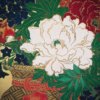The Mischievous Pranks of Soga Shōhaku: Pang Jushi (Hōkoji) and Ling Zhaonu (Reishōjo) Are Made to Look Like a Kume Hermit and a Woman

Soga Shōhaku was a painter active mainly in Kyoto during the mid-Edo period.
Known for his eccentric style, he still attracts a lot of attention today.
In this article, we will talk about the oldest known work by Soga Shōhaku, “Pang Jushi (Hōkoji) and Ling Zhaonu (Reishōjo) Are Made to Look Like a Kume Hermit and a Woman” byōbu screen, in the collection of the Museum of Fine Arts, Boston. (1759, at the age of twenty-nine).
Erotic Hermit, Kume Hermit
Kume Sennin was a legendary figure who was believed to be the founder of the Kume Temple (Kume Town, Kashihara, Nara Prefecture). He was mentioned in Buddhist literature as well as in many stories and essays.
He is said to have been born in the village of Katsuragi (present-day Gosho City to Shinjō-chō and Taima-chō, Kitakatsuragi County) during the reign of Emperor Kinmei (reigned 539?-571?). He trained at Mount Ryūmon (the boundary between Uda City and Yoshino-chō, Yoshino County) and acquired the art of divine flight.
He used to enjoy swimming in the air, but one day he saw the calf (some say thigh) of a young woman washing clothes on the banks of the Kume River and fell in lust, losing his divine power and crashing. (What the hell! You’re not a fallen angel, you’re a fallen hermit!)
Later, the Kume hermit became married to the young woman. (Really? Is that what you wanted, woman? He’s just a horny ex-hermit!)
In this painting, Soga Shōhaku depicted Kume Hermit admiring the young woman sitting on the bank of the river with her calves exposed.


By the way, Kume Hermit later served as a layman when Emperor Shōmu (reigned 724-749) built the Daibutsuden (Great Buddha Hall) at the Tōdai-ji Temple, and was engaged in transporting lumber.
Knowing that people called him a hermit, a government official asked him if he could use his divine powers to carry lumber. After about a week’s training, Kume Hermit regained his divine powers and transported lumber cut from Mt. Yoshino by levitating it into the air and landing it at the proposed construction site.
Thanks to this, the construction of the Daibutsuden was completed quickly, and Emperor Shōmu gave Kume Hermit a piece of land on which he built the Kume Temple. This is the origin of the Kume Temple.
Soga Shōhaku Parodies Pang Jushi and Ling Zhaonu
Pang Jushi was a Chinese Zen master of the Tang dynasty. During his life, he pursued the spirit of Zen without being a priest. The records of his dialogues with Zen priests, in which he maintained his position as a layman, were recorded at an early stage, and have been handed down to the present day, 1300 years later.
Ling Zhaonu, the daughter of Pang Jushi, was a Zen scholar as good as Pang Jushi, but was poor and made her living selling bamboo baskets. Ling Zhaonu, together with Pang Jushi, has long been used as a Zen painting subject, often depicting a young girl with a bamboo basket under her arm.
This is an intense work by Soga Shōhaku parodying Pang Jushi and Ling Zhaonu, depicting a Kume hermit and a beautiful woman.










